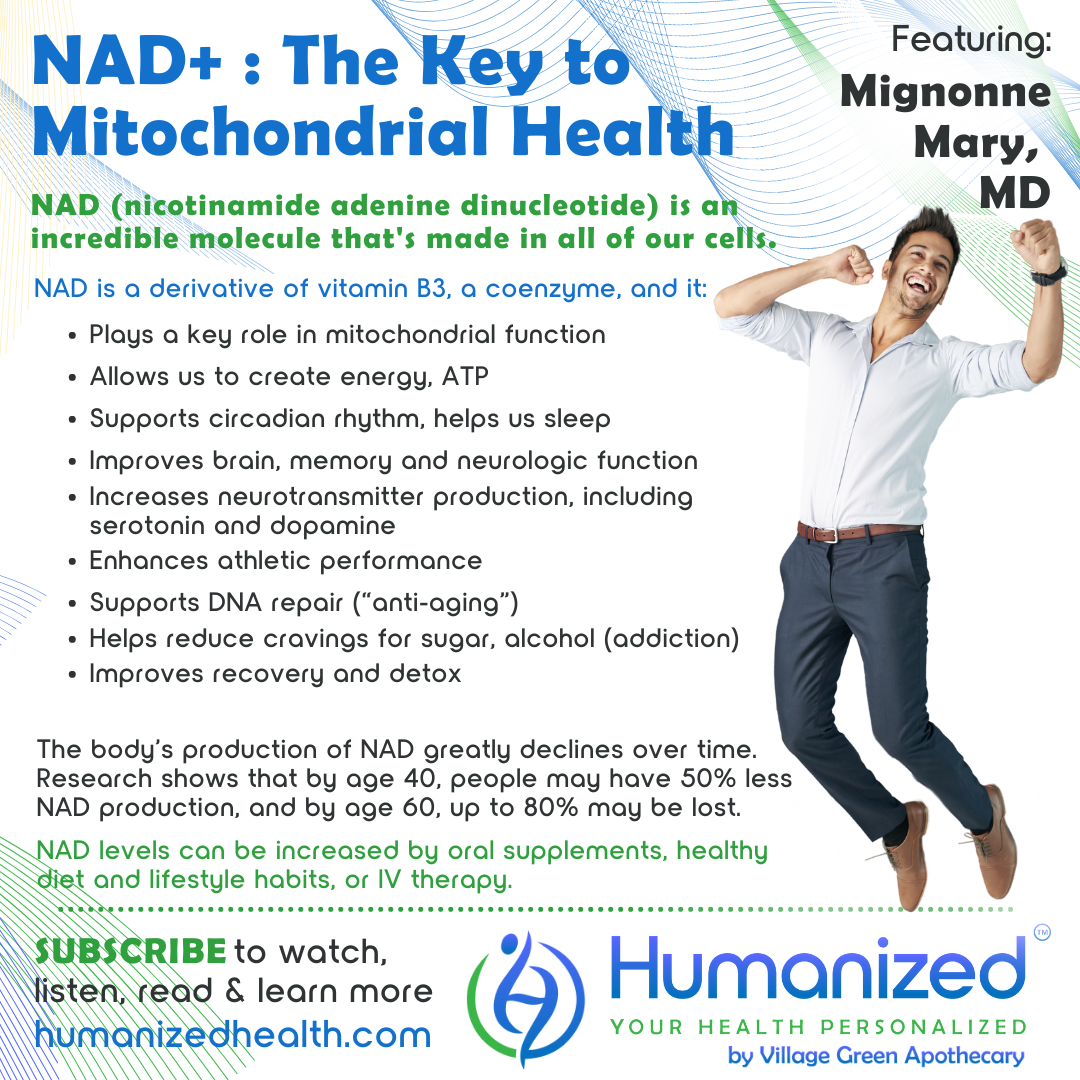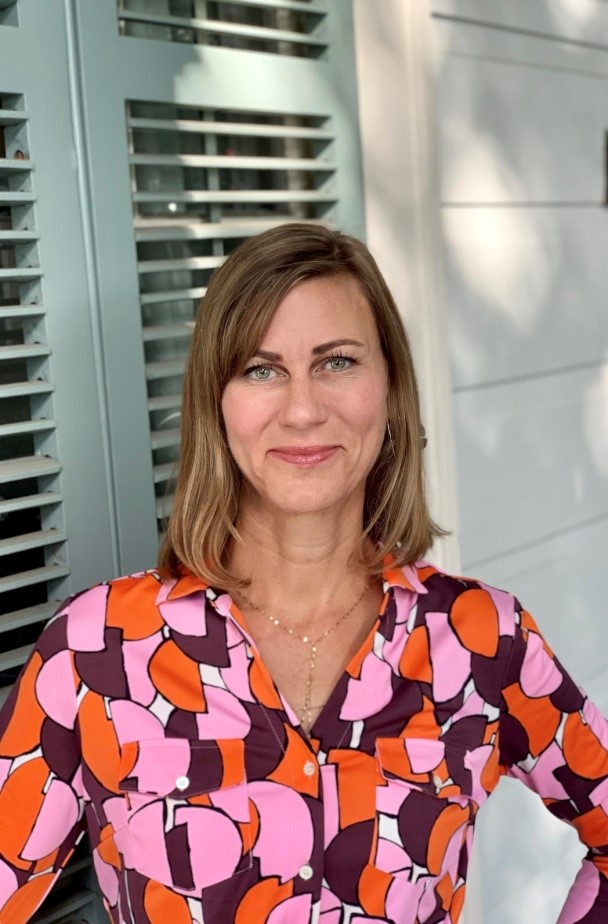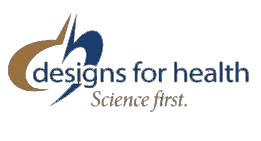NAD+: The Key to Mitochondrial Health
Featuring
Mignonne Mary, MD
WATCH
LISTEN
READ
David Stouder: Welcome to the Humanized podcast. It’s all about personalizing your health. I’m your host, filling in today, Dave Stouter. Rebekah Kelley couldn’t be with us today. Now we have a very important topic, it’s NAD+, the Key to Mitochondrial Health. Now, if you’ve done any sort of interest or reading about “anti-aging” or “aging gracefully” in a healthy fashion, having your mitochondria work efficiently and properly is critical. And we’re going to be talking about that subject with Dr. Mignonne Mary. And before I introduce Dr. Mary, I do want to remind you, if you want to get previous interviews that we’ve had with Dr. Mary and all of our health leaders, just go to MyVillageGreen.com and click on the Humanized Health link. There’s lots of great podcasts there, and they’re all free.
Now, let me tell you a little bit about Dr. Mary. She’s the founder and medical director of The Remedy Room, which is a continuation of the legacy of her father, Dr. Charles C. Mary, Jr., a pioneer in the field of IV vitamin therapy, meaning intravenous. Dr. Mary’s passion for the benefits of infusion therapy began with her father and have since developed through the years of her own practice and continued education. Today, Dr. Mary’s clinic focuses on treating the whole person, not just symptoms, and that is so much what we need – health promotion and disease prevention. The Mary family’s innovative approach to wellness and recovery has changed thousands of people’s lives and continues to grow each year. Dr. Mary currently practices internal medicine out of The Remedy Room with an emphasis on nutrition and integrative medicine to use the best that every field has to offer us.
Dr. Mary, I’m so glad to have you with us today.
Mignonne Mary: Thank you for having me this morning. I appreciate it.
David Stouder: Now, you know, there are so many health topics that people talk about, and some of them are very fairly specific to certain health issues, but there’s certain things that are just broadly impactful to the whole body. We think of maybe the microbiome, and probiotics might be one of these things. Even vitamin D3 with all of its many uses. But I’m not sure everyone has really heard about NAD, and I’ll let you tell us what that stands for. So what exactly is NAD and what does it do in the body?
Mignonne Mary: Okay. So NAD stands for nicotinamide adenine dinucleotide, which is a chemical term or name for a coenzyme. It’s a derivative of vitamin B3. So most people know that vitamin under the name niacin. And then, back in the day, and even currently, there are some doctors, cardiologists specifically, who use niacin in high doses for heart disease as well as cholesterol improvement. And then back in the earlier, like in the ’60s, there’s a doctor named Abram Hoffer, who is actually the one who introduced Linus Pauling to the world of vitamin C and kind of bolstered his love of these nutrients, as well as vitamin C, niacin. So this is where Linus Pauling created the term orthomolecular medicine, which is cellular medicine. And Hoffer was using NAD, but using it with niacin, which is its precursor, using high doses of niacin for schizophrenia and treating thousands of patients with mental disorders with it. So this is a case where doctors are using what we think is a vitamin that’s used in low levels at very high doses, almost as if it were a prescription, but with excellent results.
So it’s a derivative of B3, it’s a co-enzyme. So think of the co-enzyme like the gas, and the engine is the cells needing the gas to move forward to do what they need to do to create energy. So it helps to create ATP, which is one molecule of energy, and I would say the number one complaint in most doctors’ offices, especially post all of this viral illness, is fatigue. So people are running out of energy, they’re exhausted. And by the time we’re 40, they say that we’ve lost… the research shows that we’ve lost 50% of our production of NAD, and by the time we’re 60, we’ve lost up to 80%.
So it’s no wonder we’re getting tired as we age. And it’s no wonder we are aging rapidly because it’s responsible for so many processes in the body, and it’s made in every cell. And so without NAD, you can’t make energy, and without energy, the cells can’t go. And if they can’t go, then the body can’t repair. So you’re not able to repair DNA, which leads to misfolding, cancers and things that are scary, and neurologic conditions. And so I would say it’s a pretty incredible molecule that we are not just finding out about, but kind of it’s resurfacing itself. But because it’s in this vitamin world, it’s not ever going to be patentable, so there’s a race to the top for what could be the precursors that people could take orally without having to see a doctor. We talked about that a little bit before we started.
David Stouder: Okay. Well, yeah. And I think you laid out the case. We can say “I feel tired,” but if you really aren’t making enough energy, you’re right, it’s not just that, oh, I feel tired today, but maybe my heart isn’t working as well. My brain isn’t working as well. My digestive system isn’t working well, my immune system, on and on. So we see the critical role in this.
Now you mentioned you can get a precursor as a supplement, but you do it intravenously with your clients and patients.
Mignonne Mary: Yeah, there’s nothing like the IV. I mean, certainly this is a case where the intravenous is the best way to take it, and then the rest would fall in line after that. Then perhaps subcutaneous or intramuscularly, and then whichever your choice – intranasally, there are some sublingual lozenges, and now there’s these precursors that people can take by mouth called NR or NMN, which are the precursors. And you could also take niacin. I think the big fuss with niacin is that it causes a lot of flushing, so it deters people from taking it at the doses they would require to get to the levels that we can give, certainly in these other routes. So, nothing tops IV. Unfortunately, it is still quite expensive, and it’s more expensive from a time perspective because of the delivery. We’ve been using it over 9 years and the intravenous administration can be as easy as getting any other IV. No side effects whatsoever. No fit. The problem is, it takes a really long time, depending on what you’ve got going on in your body. So everyone is different. Men are a little bit quicker than women because they have more mitochondria and they have more musculature.
But you tapped on something that is very important, is that the number one and two places where we have the most mitochondria are going to be the heart and the brain. That’s where we need the most energy, right? And so when the person gets intravenous IV, loading those doses and then trying to keep the doses up through these other routes is really what we’re after, so that they can feel their very best and have the most impact for what they’re doing.
David Stouder: Yeah. And I think that’s, that’s so important because again, folks, if you’re fatigued all the time, you might want to think about the fact that systems in your body are fatigued all the time and that has impact you may not see.
Now, I do want to remind everybody that we will give your website out at the end of the interview, because there may be some people that want to find out about how to use IV, and certainly you provide it, and you’re in Louisiana, right?
Mignonne Mary: Yes, we have, we just closed our office in New Orleans to be in a little bit in the suburbs, in Metairie.
David Stouder: Yep. My wife lived in Metairie, that’s where her dad’s from, so I’m a little familiar with that.
Now. So obviously, you’ve been using this clinically so you can restore healthy NAD levels intravenously. Are you finding though, are people getting some efficacy with the precursor supplements?
Mignonne Mary: There are some there. I think that probably, I don’t have a definitive answer of whether it has to do with methylation or why that is, but there are certain people in our population that do very, very well with these smaller, lower level supplements and others that require the IV to really notice any kick.
Honestly, I think that, when it boils down to, whatever the disease – whether it’s Lyme, diabetes, hypertension – it’s about communication and it’s about whether or not the body can do what it’s already meant to do. So cellularly, I think that by providing more “gas” and having your body have the ability to have this coenzyme available, you’re going to see improvements. At least what we’ve seen is improvements not only in energy, but in memory, their recall is better, their sleep is better. It helps improve their circadian rhythm. Because it has DNA repair, that’s the part about the aging that everybody’s interested in, to have healthy aging. And certainly there are clinics around that are seeing much improvement in brain function and neurologic function in some of these neurologic conditions that are being problematic for people. The mental performance as well as the athletic performance is another facet of the population that’s starting to use NAD, just from the ergogenic aids and really seeing improvement in their exercise ability.
So it’s pretty neat to watch something, again from nature, that’s so powerful and also a pleiotropic molecule that has so many facets. It touches on so many parts of the body.
So, I think that the interest will only grow. The only fearful thing is the FDA trying to pull it away from people being able to use something that’s so magical – again, using nature is something we should all be doing all the time.
David Stouder: Yeah, let’s hope that that does not happen.
And a little background. You know, maybe some people get a little, what do I want to say… jaded. You know, they hear about ” the next new thing, the next new supplement.” But I’m a little familiar with the backstory of this. I watched a video at TheRemedyRoom.com, which is your website, and you mentioned Dr. David Sinclair, and many people know of him, but Sinclair was studying how to… he found that the reason why fasting and calorie restriction produce health benefits is that a family of genes get activated called the sirtuin gene, and he first found resveratrol as something that could play a role. And as he got deeper into the biology of that, that’s when NAD was sort of identified as perhaps the key molecule that was involved here. And there’s a lot of very top-notch scientists and researchers that are behind this, NAD. So this is not some little internet fad, by any means.
Mignonne Mary: Oh, no, this is…
David Stouder: So, what do you think the future of this looks like?
Mignonne Mary: Oh, I think… You know, I’ve said this numerous times to many people who have approached me in regard to using it for the addict. I don’t know if you know, but right now it’s becoming popular for people to use in everyday use and for really sort of every man and woman. In the past it was used quite heavily to help people reduce their cravings to drugs and alcohol, and it has a very powerful impact. And so what I think its use should be is that every detox facility should start with NAD. Because with NAD, we could help to take away the cravings naturally. Not have to, like in medical terms, it’s slang, but it’s called “snowing the patient.” So in order to prevent them from having withdrawals and having those terrible symptoms of withdrawals, it almost seems we give them so many more drugs like Valium and Benadryl to kind of knock them out, to not suffer the ill effect, that we’re giving them even more drugs to have to clear from their body.
There was a gentleman named Mr. O’Hallaren in the ’60s who created a patent for what they used to call DPN, which is NAD, we just changed the name of the molecule, but it’s the same molecule. And he had a study that he shared where they got the gentleman physically drunk, within a 30-minute, like within an hour, I think they give him a certain amount of whiskey, and he was so drunk, he couldn’t walk. He couldn’t walk without assistance. And then within 5 minutes of starting the NAD drip, the blood alcohol level dropped in half. So he was using it, or trying to create something where he would keep people from having a hangover. It progressed to where other doctors started using it to reduce the cravings. Because remember, it helps with neurotransmitter function and helps to increase your levels of dopamine, serotonin, and all these neurotransmitters that make you feel really well.
So where I think that NAD should be used and it’s not yet, is it really should be the first thing we do in every rehab facility. And I truly believe that if people had NAD first, they would have more of an open mind. They wouldn’t have these physical cravings. They would then be able to attend to the mental changes and the physical changes they needed to do to maintain their sobriety.
So it isn’t widespread and isn’t used for that yet. There are some facilities like Springfield Wellness that focus just on that. Many people have had great benefit because whatever it’s doing is turning off that desire, so it gives people that window of opportunity to change the behavior.
I think that it’ll be used from an athletic performance standpoint. I think it’s being used already for people who’ve had changes from heart conditions, blood sugar dysregulation, because if you can get your cells to communicate properly, then you can have your body heal itself. So the body actually naturally wants to heal. We are the ones getting in the way and are not providing what it needs. So by providing this “gasoline,” these mitochondria are able to function. And I think that most disease processes, when you boil down and you keep asking why, why, why? What do they say – ask why seven times? You’ll get down to the base or root of the problem, which is mitochondrial dysfunction.
So it seems to me, and I call it, my staff knows, I call it liquid gold. I think it’s a fantastic, amazing, incredible molecule.
David Stouder: Well, I’ve sure heard a lot about it and I want to underline what you just said, Dr. Mary. I read a book once by a fellow and he said there’s really only one disease, it’s cell malfunction. And in a way that’s another way of stating what you just said. Whatever your condition is, it gets down to mitochondrial dysfunction and so this is pretty important. So, we might even say if we really have something serious, the IV might be the most valuable, but we can supplement with the precursors and at least get sort of a daily benefit from this pretty interesting molecule.
Mignonne Mary: Right. So just timeframe, and I think it’s important to make sure that you have good quality. There’s now a lot of pharmacies popping up and, and now everybody wants to use NAD, but the quality of, I haven’t found… they’re not all equal. So it’s very important to vet the place that you’re going and to make sure that the physician’s there and that you know what you’re getting into.
David Stouder: Okay. Well, that’s good. Thank you, Dr. Mary. This is a big topic and I hope people will explore it.
Now, if you want to go to Dr. Mary’s website, and I encourage you to do so because she also has some other educational videos, which I was watching, and information on NAD. And by the way, Louisiana, New Orleans is a fun place and Metairie is a suburb. So you might want to travel down there. But you can hook up with Dr. Mary at www.TheRemedyRoom, and that’s just spelled like Remedy with a y, TheRemedyRoom.com. And I will encourage you, if you come to Humanized Health, or MyVillageGreen will lead to the same place, you’ve got a lot of these free videos, which we enjoy doing, and you’re going to learn a lot here. Dr. Mary, thank you.
We should always remember, yes, we have the supplements. Yes, we have the IV, but there’s a lifestyle that will increase NAD. Well this has been fascinating. I really appreciate you being on the podcast today. Again, folks, go to www.TheRemedyRoom.com, and you can also go to MyVillageGreen.com, our lead sponsor for the Humanized Health podcast because we want you to have the information you need to personalize your health.
Again, Dr. Mary, thanks for being with us today.









